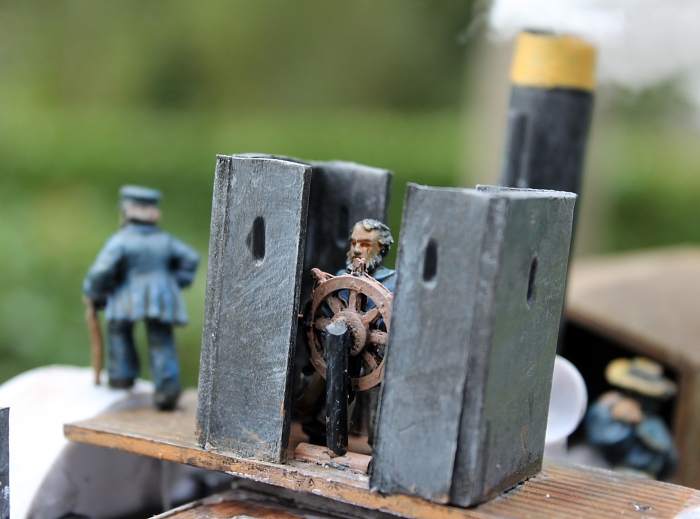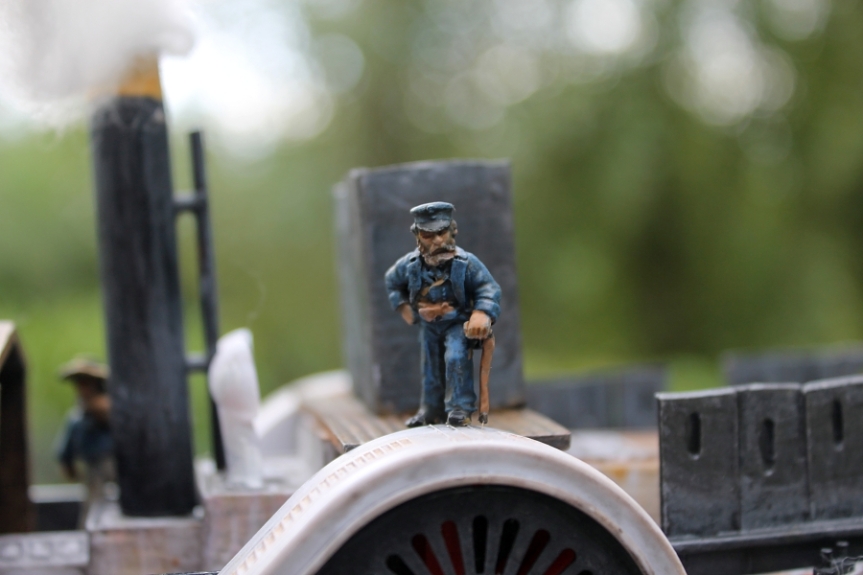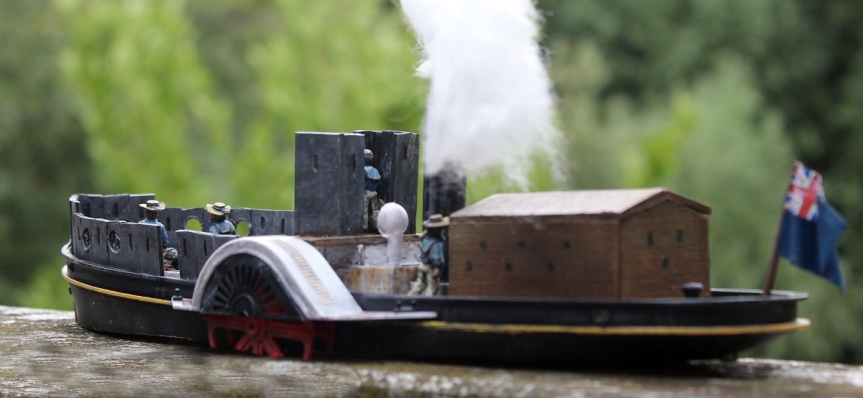When we think of gunboats for colonial wargaming, we normally picture a chunky paddle-steamer chugging up the Nile, or a little steam launch chuffing down the Congo. However, few people know that gunboats were also used in New Zealand during the colonial period.
I’ve been working on a project to model one of New Zealand’s earliest steam warships, the ‘Avon’. I’ve previously posted about how I converted her from a cheap Chinese toy tugboat. She is now finally finished, complete with Foundry crew figures.
‘Avon’ was a 58-foot iron paddle steamer, launched in Glasgow in 1859, and shipped to New Zealand to work as a pleasure boat on the River Avon in Christchurch, New Zealand. She was purchased by the government in 1862 and converted into a gunboat.
James Cowan, in his book The New Zealand Wars, describes the ‘Avon’:
The work of making the hull bullet-proof was carried out by the engineer, Mr. George Ellis (now of Auckland), who states that the ‘Avon’ was converted into an armoured steamer by having iron plates bolted inside her bulwarks. These plates were ¼ inch thick and measured 6 feet by 3 feet. The wheel was enclosed by an iron house of similar-sized plates, with loop-holes. …
… The paddle-wheeler ‘Avon’ was the first steam-vessel to float on the waters of the Waikato. She was towed to Waikato Heads on the 25th July, 1863, by HMS ‘Eclipse’ and Captain Mayne, the commander of that ship, took her inside the Heads and anchored that night eight miles below Tuakau. Next day, watched with intense excitement by the Maoris, friendlies, and hostiles alike, she reached the Bluff, otherwise known as Havelock—Te Ia-roa of the Maoris—just below the junction of the Manga-tawhiri with the Waikato. She was not fired upon, contrary to the expectations of her crew, who expected a volley from the southern bank of the river at the narrower parts. Mr. Strand, of Kohanga, assisted to pilot the ‘Avon’ up the river.
On the 7th August Captain Sullivan (HMS ‘Harrier’), senior naval officer in New Zealand, took the vessel on a reconnaissance up the river, and near Meremere she became a target for Maori bullets for the first time. A volley from some Maoris under cover on the river-bank was replied to with the 12-pounder Armstrong. On several occasions later in the campaign the ‘Avon’ was under fire. This little pioneer of steam traffic on the Waikato proved an exceedingly useful vessel. When the army reached the Waipa Plains she carried stores up as far as Te Rore, on the Waipu; it was near there that Lieutenant Mitchell, RN, of HMS ‘Esk’, was killed on board her (February, 1864) by a volley from the east bank of the river. …
… Mr. George Ellis, of Auckland, who was engineer of the ‘Avon’, says: “Lieutenant Mitchell’s death occurred in this way: We carried out rather dangerous work in the later stages of the war when running up and down the Waipa River. Sometimes we took shots at anything that offered on the banks, and even landed to go pig-hunting. One very warm summer day, when steaming up the Waipa near Whatawhata, Mr. Mitchell remarked that it was too hot to remain in the iron wheel-house and that he would go outside; he declared that he would not be shot that day. He walked out on to the open part of the bridge-deck, and Lieutenant Easther (in command) and Midshipman Foljambe (father of the present Lord Liverpool) followed him. They had not been long there before a sudden volley was fired from the scrub-covered bank of the river—the east or proper right bank. The three officers were close together, with Mr. Mitchell in the middle, and, curiously, it was only the man in the middle who was hit. The volley was fired at an oblique angle. Mr. Mitchell was shot right through the breast, and died next day. We never saw a Maori, so thick was the cover on the bank.”


‘Avon’ displaced 43 tons, was nearly 18 metres in length, and mounted a single 12-pounder Armstrong breech-loading gun on her bow. Her shallow draft of just one metre made her ideal for river operations. Besides the metal plate armour, a wooden shed-like structure with loop-holes was later built on the aft deck to provide cover for troops.
She even had her own rudimentary self-defence system: pipes were fixed in connection with the boiler, so that a stream or jet of scalding water could be thrown upon any party attempting to board.
I’m not sure how, or if I’ll ever use her in a wargame. But it has been an interesting little project to bring to life a little-known piece of New Zealand maritime and military history.







Great work, Roly! Certainly a superb centre piece for one of your display games. It would be a shame for it not to see action after all the effort you put into making it.
Wonderful model Roly! Good stuff. Yeah, NZ’s Waikato war river gunboat history isn’t well known, but it needs to be. I have a couple of articles about to be published on that very subject in the US – couldn’t find a pic of Avon, alas. Would I be able to use one of yours of your model? Email me! 🙂
Absolutely – feel free. There are also some illustrations of Avon in the Middlemass book (paintings from the period and also modern plan views of Avon and her sisters in the flotilla).
Thank you! I’ll send you a link when published.
This might interest you, Matthew -a short piece of film depicting a model paddle steamer, taken in about 1915. The model looks vaguely like another Waikato steamer, the ‘Koheroa’ (apart from the turret or conning tower on top of the superstructure) . https://ngataonga.org.nz/collections/catalogue/catalogue-item?record_id=64248
Actually, the model in the old film may be ‘Rangiriri’, not ‘Koheroa’, as a description in Cowan does give the former a tower of some sort: “This boat, which can turn easily in the space of a little more than her own length, may follow the bendings of such a river as the Waikato in its narrowest part, and may either be used as a steam-tug, towing flats for the conveyance of troops, or may be armed with guns at each of the singular- looking portholes [embrasures] which are closed with folding-doors in the middle of the lower deck ; while the bulwarks on each side are pierced with twenty or thirty loopholes for rifle shooting, and the covered platform or tower amidships will afford cover to a number of men whose fire commands the river and its banks. The paddle-wheel is placed astern of the vessel so as to take up less room.”
And the old model matches this picture of ‘Rangiriri’: http://nzetc.victoria.ac.nz/etexts/Cow01NewZ/Cow01NewZ311a.jpg
Thanks for the heads-up! Intriguing piece of footage, kind of has a ‘Thunderbirds’ feel! I am pretty sure that is Rangiriri – I have a picture in Part 2 of my article on the gunboats. Part 1 – with your photo of Avon – is published today – do feel free to jump across and have a look: https://www.navygeneralboard.com/gunboats-on-new-zealands-waikato-river-1863-part-1/
Great work, Roly. An excellent conversion.
Lovely!
Excellent work, it’s been forty years since I picked up a book about the Durham light infantry in New Zealand! Inspiration All!
Absolutley fabulous Roly, you should be very proud of this.